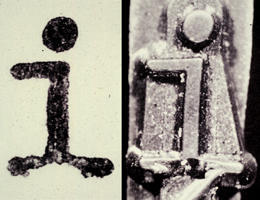
Machine Impression

Mechanical impressions are impressions placed on a piece of paper by a machine or simple tool. It is often possible to identify the impression left on a document as produced by one particular machine or tool to the exclusion of all other machines. It is also possible to determine whether two documents have a common source. Whenever possible the original typewriter, check writer, notary seal or rubber stamp should be submitted to the laboratory . It is best whenever possible to submit the typewriter to the laboratory and allow lab personnel to prepare exemplars for analysis. The following guide should be adhered to if the actual machine cannot be submitted:
Typewriters
NOTE: If the typewriter uses a one-time carbon ribbon system, no samples should be taken on the ribbon in the machine at the time it is found. The onetime use ribbon might contain the questioned information being sought and, therefore, samples duplicating the questioned text should not be taken. The ribbon should be removed and submitted to the laboratory along with the questioned document. A new ribbon should be placed in the machine to take samples as follows:
- Checks – three to five repetitions of the date, payee name, and the written and numerical amounts on each check
- Anonymous Notes and Letters – three to five repetitions of the exact text
- Other documents – three to five repetitions of the questioned entries
- A complete strike-up of all letters, numbers and special characters